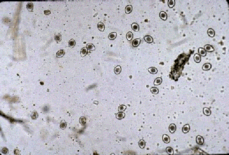
YOUR DOG'S HEALTH

Wendy C. Brooks, DVM, DABVP
There are many different species of
coccidia for dogs and cats, but the most common infections are with coccidia of
the genus Isospora (pictured here). The information presented here
pertains to Isospora species
What on Earth are Coccidia?
Coccidia are single celled organisms
that infect the intestine. They are microscopic parasites detectable on routine
fecal tests in the same way that worms are but coccidia are not worms and they
are not visible to the naked eye. Coccidia infection causes a watery diarrhea
which is sometimes bloody and can even be a life-threatening problem to an
especially young or small pet.
Where do Coccidia Come From?
Oocysts (pronounced o'o-sists), like
those shown above, are passed in stool. In the outside world, the oocysts begin
to mature or “sporulate.” After they have adequately matured, they become
infective to any host (dog or cat) that accidentally swallows them.
To be more precise, coccidia come from fecal-contaminated ground. They are swallowed when a pet grooms/licks the dirt off itself. In some cases, sporulated oocysts are swallowed by mice and the host is infected when it eats the mouse. Coccidia infection is especially common in young animals housed in groups (in shelters, rescue areas, kennels, etc.). This is a common parasite and is not necessarily a sign of poor husbandry.
How Are Coccidia Detected?
A routine fecal test is a good idea for any new puppy or kitten whether there
are signs of diarrhea or not as youngsters are commonly parasitized. This sort
of test is also a good idea for any patient with diarrhea. The above
illustration demonstrates coccidia oocysts seen under the microscope in a fecal
sample. Coccidia are microscopic and a test such as this is necessary to rule
them in. It should be noted that small numbers of coccidia can be hard to detect
so just because a fecal sample tests negative, this does not mean that the pet
is not infected. Sometimes several fecal tests are performed, especially in a
young pet with a refractory diarrhea; parasites may not be evident until later
in the course of the condition.
How is Coccidiosis Treated?
We do not have any medicine that will kill coccidia; only the patient’s immune
system can do that. But we can give medicines called “coccidiostats” which can
inhibit coccidial reproduction. Once the numbers stop expanding, it is easier
for the patient’s immune system to “catch up” and wipe the infection out. This
also means, though, that the time it takes to clear the infection depends on how
many coccidia organisms there are to start with and how strong the patient’s
immune system is. A typical treatment course lasts about a week or two but it is
important to realize that the medication should be given until the diarrhea
resolves plus an extra couple of days. Medication should be given for at least
five days total. Sometimes courses as long as a month are needed.
The use of sulfa drugs in pregnancy can cause birth defects. Sulfa drug use can also lead to false positive test results for urine glucose.
Can People or Other Pets Become
Infected?
While there are species of coccidia that can infect people (Toxoplasma and
Cryptosporidium, for example), the Isospora species of dogs and cats are not
infective to people. Other pets may become infected from exposure to infected
fecal matter but it is important to note that this is usually an infection of
the young (i.e. the immature immune system tends to let the coccidia infection
reach large numbers where the mature immune system probably will not.) In most
cases, the infected new puppy or kitten does not infect the resident adult
animal.
![]()